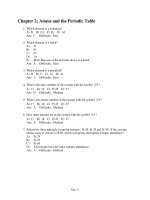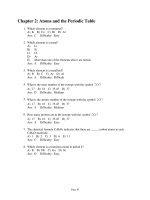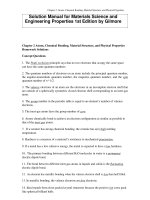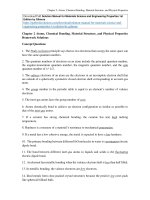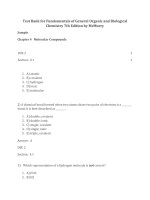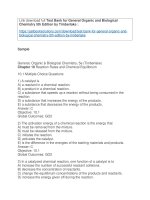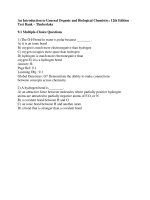Solution manual for general organic and biological chemistry 7th edition by stoker
Bạn đang xem bản rút gọn của tài liệu. Xem và tải ngay bản đầy đủ của tài liệu tại đây (300.12 KB, 7 trang )
Solution Manual for General Organic and Biological Chemistry 7th Edition by Stoker
Full file at />
Basic Concepts About Matter
Chapter 1
Problem-Set Solutions
1.1
All samples of matter have (1) mass and (2) occupy space.
1.2
Chemists are particularly interested in (1) the characteristics of matter, (2) the composition of
matter, and (3) the transformations of matter.
1.3
Air, pizza, and gold are matter because each has mass and occupies space. Sound is a form of
energy.
a. matter
b. matter
c. energy
d. matter
1.4
a. matter
b. matter
c. energy
d. matter
1.5
a. Liquids have an indefinite shape; solids have a definite shape.
b. Gases have an indefinite volume; liquids have a definite volume.
1.6
a. definite volume
1.7
a. Copper wire does not take the shape of its container; yes, it does have a definite volume.
b. Oxygen gas does not have a definite shape nor a definite volume. It takes the shape and
volume of its container.
c. Each granule of sugar has its own definite shape; however, the granules are small, so
the general shape of the mass of crystals does take the shape of the container. Yes,
granulated sugar has a definite volume.
d. Liquid water takes the shape of its container; yes, it has a definite volume.
1.8
a.
b.
c.
d.
takes shape of container; no, definite volume
takes shape of container; yes, indefinite volume
takes shape of container; yes, indefinite volume
takes shape of container; no, definite volume
1.9
a.
b.
c.
d.
The state of a substance is a physical property.
Ignition on heating with air produces a new substance, so this is a chemical property.
A new substance is produced (hydrogen gas), so this is a chemical property.
Density is a physical property.
1.10
a. physical property
c. physical property
1.11
a. Chemical. The key word is “reacting,” which indicates that a new substance is formed.
b. Physical. Red color can be observed without the formation of a new substance.
c. Chemical. The toxicity of beryllium indicates that it produces a change of
substances in the human body.
d. Physical. Pulverizing a substance changes its shape.
1.12
a. physical
b. indefinite shape
b. chemical property
d. chemical property
b. chemical
c. physical
d. physical
© 2016 Cengage Learning. All Rights Reserved. May not be scanned, copied or duplicated, or posted to a publicly accessible website, in whole or in part.
Full file at />
1
Solution Manual for General Organic and Biological Chemistry 7th Edition by Stoker
Full file 2at />
Problem-Set Solutions Chapter 1
1.13
a.
b.
c.
d.
Chemical. The word “reaction” indicates the inability to form a new substance.
Chemical. The word “reacts” indicates that a new substance is formed.
Physical. Change of state is a physical property.
Physical. Change of state is a physical property.
1.14
a. chemical property
c. physical property
1.15
a. Physical change. The leaf changes shape, but the crushed leaf is not a new substance.
b. Physical change. The metal has changed shape, but it is not a new chemical substance.
c. Chemical change. Burning is always a chemical change because new substances are
formed.
d. Physical change. The ham changes shape, but it is still ham; no new substance is formed.
1.16
a. physical
1.17
a.
b.
c.
d.
1.18
a. chemical
1.19
a. Physical. Ice and liquid water are the same substance in two different forms.
b. Physical. Crushed ice and ice chips are both forms of water; no new substance is formed.
c. Chemical. Burning a newspaper produces a change in its chemical identity; the gases,
charred paper, etc., formed are new substances.
d. Physical. Pulverizing a sugar cube produces a new shape, but the substance is still sugar.
1.20
a. physical
1.21
a.
b.
c.
d.
1.22
a. chemical change
1.23
a. False. A heterogeneous mixture contains two or more substances.
b. True. A pure substance contains only one substance, and so has a definite composition.
c. False. Substances maintain their identity in all mixtures; they are physically mixed, not
chemically combined.
d. True. Most substances in the “everyday world” are mixtures.
1.24
a. true
1.25
a. Heterogeneous mixture. “Two substances” makes this a mixture; “two phases” shows that
it is not uniformly mixed.
b. Homogeneous mixture. “One phase” indicates that the mixture of two substances has
uniform properties throughout.
c. Pure substance. The two phases present represent two forms of a single substance (for
example, ice and liquid water).
d. Heterogeneous mixture. The existence of three substances in three different phases
indicates that the substances are not mixed uniformly.
b. chemical property
d. physical property
b. chemical
c. physical
d. physical
Physical. Mechanical changes are physical.
Physical. A change of state, from liquid to solid in this case, is always a physical change.
Chemical. The smell of sour milk indicates that a new substance has been formed.
Physical. Breaking or cutting is always a physical change.
b. physical
b. physical
c. chemical
c. chemical
d. physical
d. physical
Chemical change. Burning a newspaper produces new substances.
Chemical property. Metallic copper reacts with chlorine gas to produce a new substance.
Physical change. Ice melting is a change of state. No new substance is produced.
Physical property. The state (solid) of a substance (gold) is a physical property.
b. physical property
b. false
c. true
c. physical change
d. physical property
d. false
© 2016 Cengage Learning. All Rights Reserved. May not be scanned, copied or duplicated, or posted to a publicly accessible website, in whole or in part.
Full file at />
Solution Manual for General Organic and Biological Chemistry 7th Edition by Stoker
Full file at />Problem-Set Solutions Chapter 1
3
1.26
a. homogeneous mixture
c. pure substance
1.27
a. Homogeneous mixture, one phase. The word “dissolved” indicates that the salt is
uniformly distributed throughout the salt-water mixture.
b. Heterogeneous mixture, two phases. The undissolved sand is not uniformly mixed with the
water.
c. Heterogeneous mixture, three phases. The three phases present are ice (solid), liquid water,
and liquid oil. The two liquids are not soluble in one another; they are separate phases.
d. Heterogeneous mixture, two phases. The water solution (water and dissolved sugar) is one
phase; the undissolved sugar is the other phase.
1.28
a. homogeneous mixture, one phase
c. heterogeneous mixture, three phases
1.29
a. Compound. A single substance (A) made up of two elements is a compound.
b. Compound. B must contain more than one element to decompose chemically, so it is a
compound.
c. Classification is not possible because not enough information is given.
d. Classification is not possible. Melting is a physical change that both elements and
compounds can undergo.
1.30
a. element
c. classification not possible
1.31
a. For A and B, classification is not possible. C is a compound because it contains the
elements in A and B.
b. D is a compound because it breaks down into simpler substances. It is not possible to
classify E, F, and G.
1.32
a. A, compound; B, classification not possible; C, classification not possible
b. D, classification not possible; E, classification not possible; F, classification not possible;
G, classification not possible
1.33
a. True. An element contains one kind of atoms and so is a single pure substance. A
compound has a definite, constant composition, so it is also a pure substance.
b. False. A compound results from the chemical combination of two or more elements.
c. False. In order for matter to be heterogeneous, at least two substances (either elements or
compounds) must be present.
d. False. Both compounds and elements have a definite composition.
1.34
a. true
1.35
The first box is an analogy for a mixture; the nuts and bolts are not evenly distributed. The
second box is an analogy for a compound; each bolt is attached to a nut.
1.36
First box: mixture; second box: compound
1.37
a.
b.
c.
d.
b. false
b. pure substance
d. heterogeneous mixture
b. heterogeneous mixture, two phases
d. homogeneous mixture, one phase
b. classification not possible
d. classification not possible
c. true
d. false
Compound. A compound is a substance that contains more than one element.
Mixture. Two substances are “mixed” together; this is a mixture.
Element. A substance that cannot be decomposed by chemical means is an element.
Mixture. Since the composition is variable, this is not a compound; it is a mixture.
© 2016 Cengage Learning. All Rights Reserved. May not be scanned, copied or duplicated, or posted to a publicly accessible website, in whole or in part.
Full file at />
Solution Manual for General Organic and Biological Chemistry 7th Edition by Stoker
Full file 4at />b. mixture
Problem-Set Solutions Chapter 1
1.38
a. compound
1.39
a. Homogeneous mixture. The sample is a single phase (homogeneous); when it is boiled
away (evaporated), it reveals that there are two substances (a mixture).
b. Heterogeneous mixture. A “cloudy” mixture is not homogeneous; it has two phases.
c. Heterogeneous mixture. The sample is nonuniform; it is heterogeneous.
d. Compound. The sample is not a mixture; it cannot be separated by physical means. It
reacts with magnesium (an element) to form two compounds containing different elements.
Therefore, the sample contains more than one element; it is a compound.
1.40
a. homogeneous mixture
b. compound
1.41
a. True. Variable composition is one indication of a mixture.
b. True. The two elements are physically combined and retain their physical properties.
c. False. The elements in a compound are chemically combined and cannot be separated by
physical methods.
d. True. Elements in a compound are chemically combined.
1.42
a. false
1.43
a. True. There are a number of heavier elements that do not occur naturally.
b. False. There are 117 known elements.
c. False. Any elements discovered in the future will be highly unstable and thus not naturally
occurring.
d. False. There are 88 naturally occurring elements.
1.44
a. false
1.45
a. True. Oxygen is the most abundant element and silicon is the second most abundant
element in Earth’s crust.
b. True. Oxygen is the most abundant element in Earth’s crust.
c. False. Hydrogen and helium are the two most abundant elements in the universe as a
whole.
d. True. 60.1% of all elemental particles (atoms) within Earth’s crust are oxygen atoms.
1.46
a. false
1.47
In Earth’s crust:
a. Silicon (20.1%) is more abundant than aluminum (6.1%).
b. Calcium (2.6%) is less abundant than hydrogen (2.9%).
c. Iron (2.2%) is less abundant than oxygen (60.1%).
d. Sodium (2.1%) is more abundant than potassium (<1.5%).
1.48
a. more
1.49
a. N is the symbol for nitrogen.
c. Pb is the symbol for lead.
b. Ni is the symbol for nickel.
d. Sn is the symbol for tin.
1.50
a. lithium
c. fluorine
1.51
a. Al is the symbol for aluminum.
c. H is the symbol for hydrogen.
b. false
b. less
d. compound
b. element
d. homogeneous mixture
b. false
b. false
c. compound
c. true
c. true
c. false
c. more
b. helium
d. false
d. true
d. true
d. less
d. zinc
b. Ne is the symbol for neon.
d. U is the symbol for uranium.
© 2016 Cengage Learning. All Rights Reserved. May not be scanned, copied or duplicated, or posted to a publicly accessible website, in whole or in part.
Full file at />
Solution Manual for General Organic and Biological Chemistry 7th Edition by Stoker
Full file at />Problem-Set Solutions Chapter 1
5
1.52
a. Hg
b. Cl
c. Au
1.53
The elements and symbols are as follows:
a. Na – sodium, S – sulfur
b. Mg – magnesium, Mn – manganese
c. Ca – calcium, Cd – cadmium
d. As – arsenic, Ar – argon
Elements and their symbols may be found in Table 1.1 of your textbook.
1.54
a. Cu and Co
1.55
a.
b.
c.
d.
1.56
a. yes
1.57
a.
b.
c.
d.
1.58
a. heteroatomic
1.59
a.
b.
c.
d.
1.60
a. pentatomic
1.61
a.
b.
c.
d.
1.62
a. compound
1.63
a.
b.
c.
d.
1.64
a. must be a compound
c. could be an element or a compound
1.65
a. True. Atoms are the fundamental building blocks of both elements and compounds.
b. False. Triatomic molecules may contain one, two, or three kinds of atoms.
c. True. A compound is made up of two or more elements; its molecules must contain more
than one kind of atom.
d. False. Both heteratomic and homoatomic molecules may contain three or more atoms.
b. K and P
c. Fe and I
d. Be
d. Si and Ag
No. The symbols are Mg, N, and P.
Yes. The symbols are Br, Fe, and Ca.
Yes. The symbols are Al, Cu, and Cl.
No. The symbols are B, Ba, and Be.
b. no
c. no
d. yes
Heteroatomic. Two kinds of atoms.
Heteroatomic. Two kinds of atoms.
Homoatomic. One kind of atom.
Heteroatomic. Two kinds of atoms.
b. homoatomic
c. heteroatomic
d. heteroatomic
Triatomic. The molecule contains three atoms.
Triatomic. The molecule contains three atoms.
Diatomic. Two oxygen atoms are present.
Diatomic. One carbon atom and one oxygen atom are present.
b. triatomic
c. tetraatomic
d. hexatomic
Compound. Two kinds of atoms are present.
Compound. Two kinds of atoms are present.
Element. All atoms are of the same kind.
Compound. Two kinds of atoms are present.
b. element
c. compound
d. compound
A triatomic molecule could be an element or a compound.
A molecule containing one kind of atom is an element.
A heteroatomic molecule contains more than one kind of molecule and so is a compound.
A homoatomic molecule contains one kind of atom and must be an element.
b. must be an element
d. must be a compound
© 2016 Cengage Learning. All Rights Reserved. May not be scanned, copied or duplicated, or posted to a publicly accessible website, in whole or in part.
Full file at />
Solution Manual for General Organic and Biological Chemistry 7th Edition by Stoker
Full file 6at />
Problem-Set Solutions Chapter 1
1.66
a.
b.
c.
d.
False; a molecule of an element is always homoatomic.
False; the limit of chemical subdivision for a compound is atoms.
True
True
1.67
a. Diagram I. The molecules present must all be triatomic, identical (a pure substance), and
heteroatomic (a compound).
b. Diagram III. Two kinds of molecules must be present (a mixture), and the molecules must
all be heteroatomic (a compound).
c. Diagram II. Two kinds of diatomic molecules are present.
d. Diagrams I and IV. All molecules must be identical, but can be homoatomic (an element)
or heteroatomic (a compound).
1.68
a. diagram III
1.69
a.
b.
c.
d.
1.70
a. mixture
1.71
a. Changes 3 and 4 are physical changes; no new molecules are formed.
b. In change 1 two elements combine to form a compound; a new substance is formed.
1.72
a. changes 3 and 4
1.73
Chemical formulas for the substances represented by the models are:
a. H2O The molecule contains two hydrogen atoms and one oxygen atom.
b. CO2 The molecule contains one carbon atom and two oxygen atoms.
c. O2 The molecule contains two oxygen atoms.
d. CO The molecule contains one carbon atom and one oxygen atom.
1.74
a. CH4
1.75
a.
b.
c.
d.
1.76
a. chemical symbol of element, 1 atom
c. chemical formula of compound, 3 atoms
1.77
The chemical formulas are:
b. C8H10O4N2
a. C12H22O11
1.78
a. C12H22O11
1.79
The chemical formulas are: XZ4, X2Z3, X3Z2, X4Z
1.80
AZ5, A2Z4, A3Z3, A4Z2, A5Z
b.
diagram I and IV
c. diagram I
d. diagram III
Element. Because one kind of homoatomic molecule is present, this is an element.
Mixture. Because two phases are present, this is a mixture.
Mixture. Because two kinds of molecules are present, this is a mixture.
Mixture. Because two kinds of molecules are present, this is a mixture.
b. compound
c. compound
d. mixture
b. change 2
b. O3
c. H2O2
d. C2H4
Chemical formula of a compound. Six atoms are present in one formula unit.
Chemical formula of a compound. Five atoms are present in one formula unit.
Chemical symbol of an element. One atom is present in one formula unit.
Chemical formula of a compound. Two atoms are present in one formula unit.
b. chemical formula of compound, 2 atoms
d. chemical formula of compound, 4 atoms
b. C8H10O4N2
© 2016 Cengage Learning. All Rights Reserved. May not be scanned, copied or duplicated, or posted to a publicly accessible website, in whole or in part.
Full file at />
Solution Manual for General Organic and Biological Chemistry 7th Edition by Stoker
Full file at />Problem-Set Solutions Chapter 1
7
1.81
a. HCN. Since 3 atoms are present and 3 elements are present there can be only one atom of
each element present.
b. H2SO4. Subtracting 2 atoms of hydrogen and 1 atom of sulfur from the 7 atom total
means that 4 atoms of O are present.
1.82
a. N2O
1.83
a. The first and second formulas contain the same number of total atoms.
HN3 (1H + 3N = 4 atoms) and NH3 (1N + 3H = 4 atoms) each contain four atoms.
b. The first formula contains more total atoms. CaSO4 (1Ca +1S + 4O = 6 atoms);
Mg(OH)2 [(1Mg +2(1O + 1H) = 5 atoms]. The parentheses around the OH group indicate
that each atom in the group is multiplied by the group’s subscript.
c. The first formula contains the same number of total atoms as the second.
NaClO3 (1Na + 1 Cl + 3O = 5 atoms); Be (CN)2 [1Be + 2(1C + 1N) = 5 atoms]
d. The first formula contains fewer total atoms. Be3(PO4)2 [3Be + 2(1P + 4O) = 13 atoms];
Mg(C2H3O2)2 [1Mg + 2(2C + 3H + 2O) = 15 atoms]
1.84
a. same number
1.85
a. 1 + 2 + x = 6; x = 3
c. 1 + x + x = 5; x =2
1.86
a. 3
1.87
a. In a mixture of N2, N2H4, NH3, CH4, and CH3Cl, two kinds of molecules contain four or
fewer atoms (N2 – 2 atoms; NH3 – 4 atoms).
b. There are four kinds of atoms (N, H, C, Cl) in the mixture.
c. There are 110 atoms in a mixture containing five molecules of each substance;
5(2 + 6 + 4 + 5 + 5) = 110
d. There are 56 hydrogen atoms in a sample containing four molecules of each substance.
4(0 + 4 + 3 + 4 + 3) = 56
1.88
a. 2
b. HNO3
b. more
b. 3
b. 5
c. same number
d. more
b. 2 + 3 + 3x = 17; x = 4
d. x + 2x + x = 8; x = 2
c. 3
c. 100
d. 2
d. 9
© 2016 Cengage Learning. All Rights Reserved. May not be scanned, copied or duplicated, or posted to a publicly accessible website, in whole or in part.
Full file at />


